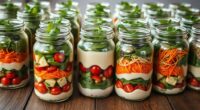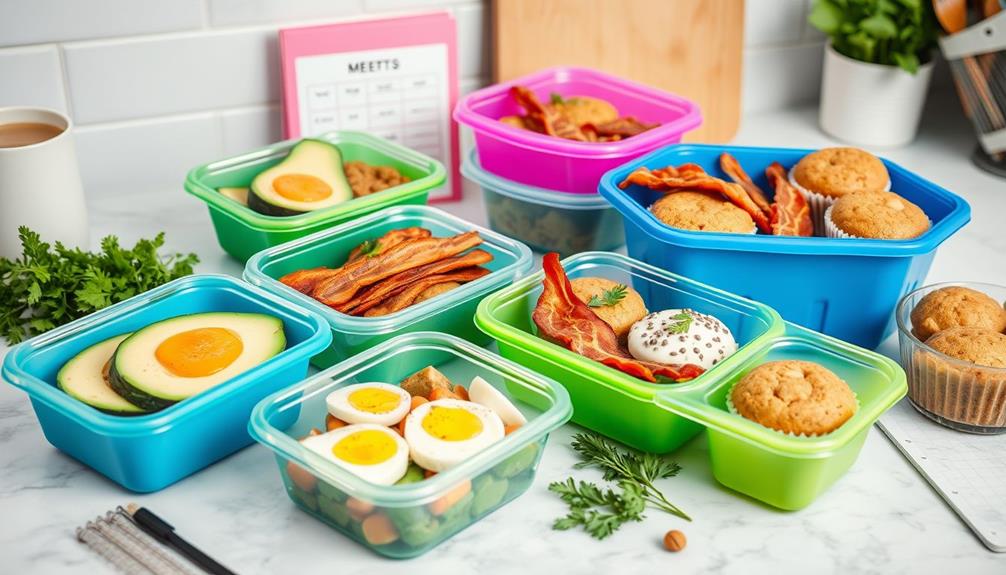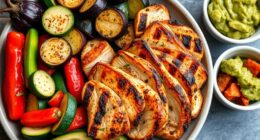By embracing seasonal meal prep, you can enjoy fresh, flavorful produce throughout the year while supporting local farmers and cutting food waste. Focus on shopping for ingredients in their peak season to maximize nutrition and taste, and preserve excess with freezing or canning. Planning your meals around crop cycles helps you stay versatile and save money. If you keep exploring, you’ll discover practical tips to make year-round healthy eating simple and sustainable.
Key Takeaways
- Plan meals around seasonal crop cycles to maximize freshness and nutritional value year-round.
- Use preservation techniques like freezing and canning to enjoy seasonal produce beyond harvest.
- Shop at local markets during peak seasons for affordable, high-quality ingredients.
- Incorporate preserved and in-season ingredients into diverse recipes to maintain variety.
- Adjust meal prep strategies to align with seasonal availability, supporting sustainability and reducing waste.

As the seasons change, so do the ingredients available at your local markets, making it the perfect time to embrace seasonal meal prep. By adjusting your meal planning to align with what’s fresh and in season, you can enjoy more flavorful dishes and make smarter grocery shopping choices. When you plan your meals around seasonal produce, you not only support local farmers but also take advantage of produce at its peak flavor and nutritional value. This approach simplifies your grocery shopping, allowing you to focus on what’s abundant and affordable, which helps you save money and reduce waste.
Start by familiarizing yourself with what’s in season during each time of the year. For example, in spring, you can look forward to fresh asparagus, peas, and strawberries. Summer brings ripe tomatoes, corn, berries, and peaches. Fall offers apples, pumpkins, squash, and root vegetables, while winter provides hearty greens, citrus fruits, and Brussels sprouts. Knowing what’s in season helps you create a flexible meal plan that revolves around these ingredients, making your grocery shopping more efficient. You can draft a weekly meal plan that emphasizes seasonal produce, so your shopping list is focused and purposeful.
When grocery shopping, always check local markets first. Seasonal produce is often cheaper and fresher than what you find in standard grocery stores. This not only boosts the flavor of your meals but also encourages you to try new recipes that highlight these ingredients. For instance, if strawberries are in season, you might prepare a strawberry spinach salad or enjoy them in smoothies. As pumpkins or squash become available, roasting them for soups or side dishes becomes both easy and delicious. By basing your shopping list on what’s in season, you avoid overbuying and minimize food waste, making your meal prep more sustainable. Additionally, knowing crop cycles can help you anticipate when certain items will be available and plan ahead for preservation.
Meal planning around seasonal ingredients also means you can prepare dishes in advance, storing them for later use. For example, you might roast a batch of seasonal vegetables or cook a large pot of soup on the weekend. These prep sessions save time during busy weekdays and allow you to enjoy fresh, nutritious meals without the last-minute rush. Additionally, incorporating variety into your meal prep keeps your diet balanced and interesting throughout the year. Utilizing preservation techniques, like freezing or canning, can extend the availability of certain ingredients beyond their natural seasons, further reducing waste and ensuring year-round access. Understanding the crop cycles of different produce can help you plan for preservation methods more effectively.
By exploring seasonal produce and learning how to store and preserve it, you can enjoy the flavors of each season long after the harvest has ended. Ultimately, embracing seasonal meal prep transforms your approach to food. It encourages creativity, promotes healthier eating, and supports local agriculture—all while keeping your meals exciting and fresh throughout the year. By aligning your meal planning and grocery shopping with seasonal produce, you make smarter choices that benefit your taste buds, your wallet, and the environment.
Frequently Asked Questions
How Can I Store Seasonal Produce for Off-Season Use?
To store seasonal produce for off-season use, you should consider freezing techniques and root cellaring. Freezing preserves fruits and vegetables quickly, locking in nutrients and flavor. Root cellaring keeps produce like potatoes and carrots cool, dark, and humid for months. You can also blanch before freezing for better quality. These methods help you enjoy fresh-tasting produce year-round without relying on store-bought options.
What Are the Best Preservation Methods for Seasonal Fruits and Vegetables?
You want to preserve seasonal fruits and vegetables, so you should consider freezing techniques like blanching before freezing to maintain freshness and flavor. Canning methods, such as water bath or pressure canning, are great for long-term storage and preserving taste. Properly using these methods guarantees you enjoy your favorite produce all year, saving money and reducing waste. Follow safety guidelines to keep your preserved produce delicious and safe to eat.
How Can I Adapt Recipes for Different Seasonal Ingredients?
When adapting recipes for different seasonal ingredients, start by ingredient swapping to match what’s available. Focus on flavor pairing to guarantee the new ingredients complement the dish’s overall taste. You can tweak herbs, spices, or cooking methods to enhance flavors. This way, you maintain the recipe’s essence while making it flexible for seasonal changes, ensuring you enjoy fresh, delicious meals year-round.
Are There Specific Tools Recommended for Seasonal Meal Prep?
Ever wonder which tools make seasonal meal prep effortless? You’ll want to explore versatile kitchen gadgets like mandoline slicers and spiralizers—they’re game changers. These prep techniques save time and keep ingredients fresh and appealing. Sharp knives and sturdy cutting boards are essentials, too. With the right tools, you can quickly adapt recipes to seasonal ingredients, revealing new flavors all year. Ready to elevate your cooking? The secret’s in those must-have gadgets.
How Do I Maintain Nutrient Quality in Preserved Produce?
To maintain nutrient retention in preserved produce, focus on proper preservation techniques like blanching before freezing or canning, which helps preserve vitamins and minerals. Use airtight containers to prevent nutrient loss from oxidation and store in cool, dark places to minimize nutrient degradation over time. Avoid overcooking during preparation, as high heat can destroy nutrients. Staying mindful of these methods ensures your preserved produce retains maximum nutritional value.
Conclusion
By embracing seasonal meal prep, you’ll enjoy fresh, flavorful produce year-round while reducing your environmental impact. It’s like having a secret garden in your kitchen, no matter the month. Plus, planning around what’s in season keeps your meals exciting and budget-friendly. So, stay ahead of the curve and channel your inner Martha Stewart—just maybe skip the powdered wigs—making every meal a delightful, fresh adventure. Happy cooking!









